Summary
- Companies aiming to meet the Paris Agreement’s goals should start by measuring emissions accurately, setting science-based targets, and prioritising abatement strategies to reduce carbon emissions across their value chains.
- Developing decarbonisation pathways through scenario modeling and regularly reporting on emissions progress ensures transparency, accountability, and alignment with global standards.
- Successful implementation requires securing C-suite support, embedding the decarbonisation strategy into core business operations, and leveraging technology for accurate emissions tracking and scenario planning.
Introduction
Meeting the Paris Agreement's targets to halve emissions by 2030 and achieve net zero emissions by 2050 is a daunting task for many companies in the UK. With mounting pressure to take immediate, meaningful steps to reduce carbon emissions, it can be challenging to know where to start.
The UK is a world leader when it comes to fighting against climate change. In 2019, the country became the first major economy to pass laws to end its contribution to global warming by 2050. This blog provides a concise summary of the crucial steps that companies in the UK must take to establish a credible path towards achieving net zero emissions. From developing top-down 1.5°C targets to building decarbonisation pathways and securing support for effective execution, this guide will help your business navigate the decarbonisation journey for large enterprises in the UK with more clarity and confidence.

Measure Emissions
The first step in the decarbonisation journey for companies in the UK is to measure emissions accurately and set a baseline. Companies must undertake a comprehensive emissions inventory, with a view of including all direct and indirect emissions across their value chain.
The Greenhouse Gas (GHG) Protocol is a globally recognised framework and accounting standard for measuring, reporting, and managing GHG emissions. It classifies GHG emissions into three types: Scope 1, Scope 2, and Scope 3. The latter are of particular importance, as they typically represent the majority of a company’s total GHG emissions.
For instance, private enterprises and government sector companies in the UK are required to report their scope 1 and 2 emissions. These enterprises are also required to report business travel which is one of the 15 categories under scope 3 emissions. Since scope 3 emissions are the largest contributors of GHG, measuring the maximum number of scope 3 emission categories can potentially be a way how large enterprises can begin their decarbonisation journey.

Set Reference Targets
After measuring emissions, the next step is to set science-based reference targets using a top-down analysis. This entails using a carbon budget approach as an objective way of determining the emissions reductions needed to limit global warming in line with the Paris Agreement, rather than being set by what is achievable by any one company.
Investors and ratings agencies are becoming more discerning about corporate climate targets and plans, and how they align with the Paris Agreement goals. As an example, research-based indexes and analytics provider MSCI uses its Implied Temperature Rise methodology to evaluate the quality of corporate climate plans.
Companies can get ahead of these external judgments by developing top-down reference targets that are consistent with the Paris Agreement’s 1.5°C pathway. The Science-based Targets initiative (SBTi) offers guidance on how companies can set reduction targets that align with the best available science using base-year emissions measurement.
Prioritise Abatement Levers
Once reference targets are set, companies should prioritise abatement levers. These are usually projects, programs, business decisions, or other actions that reduce the activities driving emissions, reduce the GHG intensity of those activities, or both. Abatement levers require companies to have prior knowledge of the hotspots across their value chain so that they can identify specific decarbonisation opportunities.
To prioritise abatement options, companies should consider a variety of factors such as the potential for emissions reduction, cost-benefit analysis, and feasibility of implementation. A useful framework that companies can leverage when prioritising levers is the mitigation hierarchy. This structured approach emphasises prevention above all else, followed by reduction, and substitution of the sources of emissions. Only after these efforts have been exhausted should remaining emissions be neutralised through biological (e.g. reforestation) or technological (e.g. carbon capture and storage) neutralisation within the value chain. Finally, companies can compensate for any remaining emissions through carbon credit offsets beyond the value chain.
It is crucial for companies to engage with partners along the value chain – both upstream and downstream – to ensure a cohesive and effective approach to emissions reduction. Collaborating with partners helps companies understand the impact of climate plans on their operations and identify areas for improvement.
Develop Decarbonisation Pathways
Following a careful identification and prioritisation of abatement levers, companies should develop pathways that outline the collective impact of various reduction strategies and actions on their emissions profile over time. This involves projecting business-as-usual (BAU) emissions as a result of company growth and simulating different “what-if” reduction scenarios to assess the effectiveness of alternative strategies.
Companies should consider aggregating simulations into a few distinct pathways to allow for comparison against reference targets. They should also strive to incorporate carbon pricing into their analyses for a more comprehensive evaluation.

Report, Disclose, Communicate
Reporting, disclosing, and communicating emission reduction efforts to external stakeholders are essential components in the decarbonisation journey. Not only do they provide transparency and accountability, but they also establish a roadmap for companies to galvanise action and build support around their decarbonisation efforts.
Reporting involves providing regular updates to investors, board members, regulators, and voluntary standards/bodies on a company's emissions, decarbonisation strategies, and progress towards set targets. For instance, companies can ensure that they are held accountable and demonstrate their commitment to decarbonisation by validating targets with SBTi and reporting to organisations such as the Carbon Disclosure Project (CDP).
Similarly, disclosing information periodically is crucial to ensuring transparency and accountability. Preparing annual reports that align with the Task Force on Climate-related Financial Disclosures (TCFD) and the Global Reporting Initiative (GRI) can help companies report on their environmental impact and how they are managing risks and opportunities. Large, publicly listed companies are increasingly being required by laws around the world to disclose their emissions and climate transition plans.
Finally, companies should communicate their sustainability and decarbonisation initiatives both internally and with the wider public. Corporate communications channels and public relations play a critical role in establishing a clear and consistent understanding of a company’s evidence-based climate transition strategy and plan among internal and external stakeholders. Such communication builds buy-in and credibility, which are crucial to an effective decarbonisation journey. Engaging in joint case studies and thought leadership efforts also helps to demonstrate a company’s commitment to decarbonisation.
The final step in the decarbonisation journey is to secure the support, resources, and tools to successfully execute decarbonisation plans. This involves obtaining C-suite approval to ensure adequate financial support and backing for the plan’s implementation. Equally important is embedding the plan into existing business processes, such as budgeting, compensation and bonuses, capital allocation, procurement, and supply chain management. This ensures that all business units are aware of their role in achieving the company's decarbonisation goals and are equipped with the necessary tools and resources to execute the climate transition plan effectively.
Conclusion
A company’s decarbonisation journey is a continuous and iterative process that starts with establishing a baseline of emissions, developing a robust climate strategy and mitigation plan, deciding on company-wide action, and continuous monitoring and reporting. This process requires both a technology platform that helps measure emissions accurately and repeatedly, simulate scenarios, and record progress over time, as well as deep sustainability expertise to help evaluate scenarios, understand abatement options, and plan reductions. By working with Terrascope, large enterprises can be confident in an end-to-end service that effectively leverages deep sustainability expertise. With strong capabilities to help your company evaluate scenarios, understand abatement options, and plan reductions, Terrascope can help achieve an effective, future-proof climate strategy. With us, your company can take its first, better steps towards net zero.


